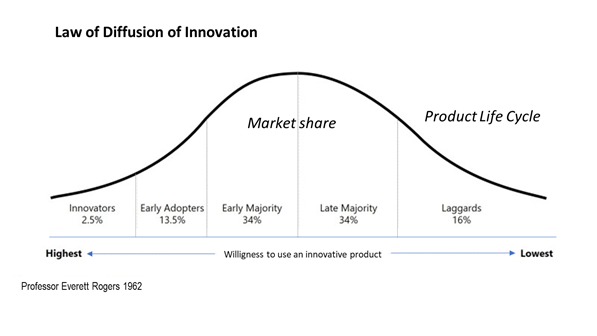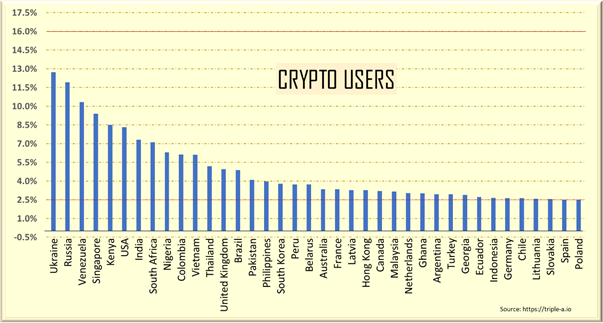El Salvador is the first country in the world to adopt cryptocurrency as the official currency for money transactions and payments. Critics of cryptocurrencies focus on the fact that cryptocurrencies have been adopted in this country because of the serious weaknesses of its financial system. They also point out that the country's population represents a very small part of the world population and therefore cannot be considered as an indication that cryptocurrencies can prevail in the world population.
But is that so? How crucial is the percentage of the world population that uses cryptocurrencies? And most importantly, how crucial are the reasons for doing so? To find the answers, we consider cryptocurrencies as innovative products that want to expand and prevail in the global market.
Cryptocurrencies as innovative products
I consider cryptocurrencies as innovative products and not as money, because to date they fulfill only a part of the use of money, i.e., transactions and payments between counterparties, by using cutting-edge technologies. In essence, cryptocurrencies do not respond and even challenge an extremely important function of money, which is the exercise of monetary policy, since with the circulation of money the authorities define the interest rate policy and money supply in the economy. Therefore, the authorities, using money with their policy, determine the overall exercise for how the economies develop and balance. This is a policy that cryptocurrencies today do not seek to engage in as they argue that this kind of policy involves forms of manipulation. But even if they wanted it to, they could not do it as they do not participate in any central monetary system.
However, on the other hand, cryptocurrencies, as a form of money, introduce a new way of money trading and payment. Through the use of cutting-edge technologies, such as blockchain technology, they are introducing a revolutionary methodology ready to bring about huge changes that may lead to a new reality in terms of transactions and payments. Therefore, cryptocurrencies are indeed innovative products and as they are considered innovative, the answer to how much and under what conditions they prevail or will prevail in the global markets, can be found based on the model defined by the Law of Diffusion of Innovations. A Law that is sometimes known as the Product Life Cycle, first published by Professor Everett Rogers, in his book in 1962, entitled Diffusion of Innovations.
Law of diffusion of innovations
According to this Law, anyone who plans to bring an innovative product that provides an idea as an effective solution to society, economy, market, entrepreneurship, etc., should know that not everyone can be willing to accept it at the same time. In fact, any innovative product such as cryptocurrency, in order to penetrate, and ultimately prevail the economy and the market, must go through certain stages. In essence, any innovative product follows the Law of Diffusion of Innovation, where the population is divided into five groups corresponding to a convex curve, as shown in the figure below:
The five groups, are:
-
Innovators.
-
Early Adopters.
-
Early Majority.
-
Late Majority.
-
Laggards.
Each group indicates the mentality that people have, to adopt and use new ideas, new products, and solutions offered to them.
Thus, according to the Law of Diffusion of Innovation, there is a percentage of 2.5% of the population that seeks new products and new ideas. Every new achievement, every innovation fascinates them and challenges them to adopt it. It is the part of the population that sees the world in a different way. It is not uncommon for this percentage of the population, to question the status quo and fight for change in order to overthrow the current regime. Because in fact, they are the ones who first and foremost promote their ideological sign which is how to build a new better world. They are the ones who support cryptocurrencies not because their goal is to make money from them. This is simply the result of supporting cryptocurrencies. The reason for supporting an innovative product like cryptocurrencies is that these people are looking for a way to change the world.
The interesting thing is that this small percentage of 2.5% is enough to motivate a much larger percentage and to inspire them to the goal of changing the world. According to the Law, a percentage of 13.5%, the so-called Early Adopters are ready to accept and be inspired by what the innovators propose. They are the ones who see value in the innovative idea to the extent that they are very willing to accept even the imperfections and disadvantages of innovation because they believe that they can discern the great potential that exists in this innovation. They are often the leaders of public opinion in a market and hold quite high professional and social positions, so they can influence others. These two groups have a lot in common, with the predominant one being that they rely on their intuition as they trust their instinct.
The next group that makes up 34% of the population the so-called Early Majority are those who are waiting to see the reaction of Early Adopters before they have enough confidence to try some innovation. Next to them, the Late Majority, which also makes up 34% of the population, is usually much more resilient to testing new innovations and usually waits until innovation develops to the point where new products become the norm in the market. Those who belong to the above two groups are people who have a practical and wide way of thinking where logic is the one that matters most.
The final group that makes up 16% of the population, The Laggards, are those who refuse to try innovation for as long as possible. They want to continue to use what they already have, and it is extremely difficult for them to admit that it is worthwhile to adopt a new innovative product unless they are forced to do so because they have no other choice.
Laying to the curve
Each person can be found in different parts of the curve. When a person belongs to one side of the curve, it is difficult to understand those on the other side of the curve. In fact, those on one side believe that the behavior of those on the other side does not make sense.
The further to the right we go to the curve, the more people we will find who, while seeing interest in an innovative idea provided to them, find it difficult to accept and adopt it. The reason for this behavior is that these people find it difficult to believe in an innovative idea because almost everything for them is related to a deep personal interest and not to general moral values.
But for those who create new innovative products such as cryptocurrencies, the goal is to move in the curve of the model as far to the right as possible, in order to conquer all those in the center of the curve and thus gain maximum acceptance even for those who find it difficult to believe in an innovative idea. That is, they are essentially targeting the Early and Late Majority where these two groups are at the center of the curve and occupy the largest part of the population which amounts to 68%.
People who invent products, sometimes aim directly at the center of the curve, that is, directly at the Early and Late Majority groups, ignoring the groups on the left side of the curve that are the Innovators and Early Adopters as they consider that these groups because they represent a relatively small part of the population, are not important. If they do so, they are making a huge mistake because the reality is that Innovators and Early Adopters are the "spearhead" for an innovative product to gain maximum acceptance.
The importance of early adopters
So, if creators and proponents of innovative products try to convince for the value of the product they offer, to those in the Early and Late Majority by ignoring Innovators and Early Adopters, then they are following a perfect recipe for failure. Without Innovators and Early Adopters, any penetration into the Early and Late Majority will not be able to succeed easily. This is due to the fact that groups of people belonging to the Early and Late Majority do not feel comfortable with innovation. And therein lies the great value of Innovators and Early Adopters, as they are the ones who see great value in innovation as they are the ones who believe in innovation and therefore are the only ones who can effectively influence everyone else to feel comfortable with an innovative product.
Take for example what is happening today with the pandemic case. A large part of the population belonging mainly to the Early and Late Majority and of course to the Laggards are not willing to get the vaccine which is really a huge innovation. The more a government focuses on Early Adopters, the easier it will be for the vaccine to penetrate the center and right side of the curve. Those countries that have focused more on Early Adopters are those that have achieved high levels of vaccination.
However, many who create new products do not follow this strategy. In fact, they are pursuing an even more erroneous strategy: this is pressure through manipulation. Applying pressure by manipulating people so that a product can penetrate the center of the curve is a practice that is unfortunately followed by many. But when practices of manipulation are used, people will never be loyal to that product and therefore will never trust it. Moreover, they will never feel comfortable with this product which means that at some point they can easily challenge it when they find something better than it. Manipulation is why many innovative products and services, although by using manipulation can be found in the middle of the curve, cannot stay in it for long.
The case of cryptocurrencies
Focusing now on the case of cryptocurrencies and reviewing all the previous ones we can draw useful conclusions about the future of cryptocurrencies.
Let's first look at the percentage of those who use cryptocurrencies. According to the report Measuring Global Crypto Users by crypto.com, the number of cryptocurrency users worldwide reached 221 million in June 2021. This means that the penetration of cryptocurrencies in relation to the world population is about 2,8%. It is estimated that this number will increase by the end of the year, reaching 300 million users, representing 3.9% of the world's population.
It is obvious that this is a general approach and that every region on earth is different from each other.
According to the data from triple-a.io, as presented in the chart above the greatest penetration of cryptocurrencies has taken place in the developing countries or in the countries that have a great relationship with them, but also in countries that have a high tendency towards innovation. There is a set of 100 countries where cryptocurrencies have a penetration of 0.90% to 2.5% and a total of 38 countries where the penetration of cryptocurrencies as shown in the chart above is from 2.5% to 12.75%.
If we apply these percentages to the model we discussed above, it would be difficult to assume that the users of the cryptocurrencies belong to the center of the curve, that is, they belong to the Early and Late Majority category. Rather, we assume that the current users for the innovative cryptocurrency product are people who stand mainly on the left side of the curve, which means that most users belong to the group of Innovators and Early Adopters who cover the curve up to 16%. However, in no country has the penetration of cryptocurrencies reached a critical level of 16%.
Enhancing value and capitalization
According to the model, those who belong to the categories of the curve area up to 16% are the Innovators and Early Adopters who are the ones who support and follow the cryptocurrencies faithfully thus, therefore, the penetration of cryptocurrencies up to the level of 16% for the aforementioned countries but also for the whole world, seems to be possible. In such a scenario, it is perceived that the growth of the cryptocurrency market will be huge, since, from the 3.9% of global penetration that is estimated to be formed in 2021, it will aim at the critical but feasible, according to the model, limit of 16%.
An interesting question is if today where the penetration of cryptocurrencies worldwide is estimated at just under 4%, their capitalization is about $ 2.8 trillion, how much can this capitalization reach, at the achievement of the penetration target of 16%? Obviously, an answer to this question would be difficult to give, as many quantitative and qualitative features of cryptocurrency pricing and therefore capitalization would need to be incorporated if their global penetration rate eventually reached 16%.
But even if the 16% target is reached, perhaps the most crucial thing is whether it can finally exceed this limit. That is if it can penetrate the area of Early and Late Majority that are located in the center of the curve and make up 68% of the population, thus certifying its universal acceptance in the market.
In order to achieve the goal of being accepted, at least the following three conditions are required:
The first is to give a lot of emphasis to Early Adopters because they are the only ones who can talk about the value ideas of a better world through the use of cryptocurrencies. According to triple-A.io, 82% of cryptocurrency holders have a bachelor’s degree or Master's and Ph.D. degrees and 36% of them have an annual income over US$100k. This means they are people who can transmit the values and ideas of cryptocurrencies.
Second, cryptocurrencies should focus more on the practical and comprehensive solutions required by the Early and Late Majority. Indeed, cryptocurrencies provide practical solutions to a number of serious problems in transactions and payments. However, this remains to be structured and understood how that works to their interest to Early and Late Majority.
Third, proponents of cryptocurrencies should avoid any form of manipulation, both in terms of how cryptocurrencies work and in how they perceive the ideas they express to users. After all, one of the reasons its creators created and introduced cryptocurrencies is because they claim that established currencies, using money supply, become a means of manipulation by governments and institutions. On the other hand, many who criticize cryptocurrencies believe just the opposite. That is, cryptocurrencies are a means of manipulating the market.
In summary, although cryptocurrencies are difficult to consider today as a holistic form of money, given that they can have the critical mass of people (the Early Adopters) to express the great idea, that cryptocurrencies represent, and as they can offer practical solutions for the interest of the majority of the people (concerning the Early and late majority), if it can be avoid being considered as currencies of manipulation, they will have all the backgrounds to overcome critical percentages of the population, so that eventually they can become innovative products of widely accepted, thus enhancing their value and capitalization over time.
It remains to be seen if they will finally succeed.
CFDs are complex instruments and come with a high risk of losing money rapidly due to leverage. You should consider whether you understand how CFDs work and whether you can afford to take the high risk of losing your money. The Article/Information available on this website is for informational purposes only, you should not construe any such information or other material as investment advice or any other research recommendation. Nothing contained on this Article/ Information in this website constitutes a solicitation, recommendation, endorsement, or offer by LegacyFX and A.N. ALLNEW INVESTMENTS LIMITED in Cyprus or any affiliate Company, XE PRIME VENTURES LTD in Cayman Islands, AN All New Investments BY LLC in Belarus and AN All New Investments (VA) Ltd in Vanuatu to buy or sell any securities or other financial instruments in this or in in any other jurisdiction in which such solicitation or offer would be unlawful under the securities laws of such jurisdiction. LegacyFX and A.N. ALLNEW INVESTMENTS LIMITED in Cyprus or any affiliate Company, XE PRIME VENTURES LTD in Cayman Islands, AN All New Investments BY LLC in Belarus and AN All New Investments (VA) Ltd in Vanuatu are not liable for any possible claim for damages arising from any decision you make based on information or other Content made available to you through the website, but investors themselves assume the sole responsibility of evaluating the merits and risks associated with the use of any information or other Article/ Information on the website before making any decisions based on such information or other Article.
Recommended Content
Editors’ Picks

These 5 altcoins are rallying ahead of $16 billion FTX creditor payout
FTX begins creditor payouts on January 3, in agreement with BitGo and Kraken, per an official announcement. Bonk, Fantom, Jupiter, Raydium and Solana are rallying on Thursday, before FTX repayment begins.

ETH could see new all-time high in 2025 as blobs top burn leaderboard
Ethereum (ETH) is down 1% on Tuesday following a weeklong consolidation of the general crypto market. The top altcoin could be set for a bullish 2025 if blobs continue their recent trend of burning high amounts of ETH.

PEPE Price Prediction: Last-minute $121M whale demand sparks 1,500% 2024 rally
PEPE price surged 25% within the last 24 hours, decoupling from the broader crypto market’s year-end volatility. With whales spotted entering last-minute buying frenzy, can PEPE breach the $0.000025 resistance?

These three narratives could fuel crypto in 2025, experts say
Crypto narratives like Real-World Asset tokenization, Artificial Intelligence and Bitcoin as a treasury asset could gain relevance in 2025. Experts say meme coins could emerge as a key vertical next year and strike a cautious note about Solana and XRP ETFs.

Bitcoin: 2025 outlook brightens on expectations of US pro-crypto policy
Bitcoin price has surged more than 140% in 2024, reaching the $100K milestone in early December. The rally was driven by the launch of Bitcoin Spot ETFs in January and the reduced supply following the fourth halving event in April.

Best Forex Brokers with Low Spreads
VERIFIED Low spreads are crucial for reducing trading costs. Explore top Forex brokers offering competitive spreads and high leverage. Compare options for EUR/USD, GBP/USD, USD/JPY, and Gold.

